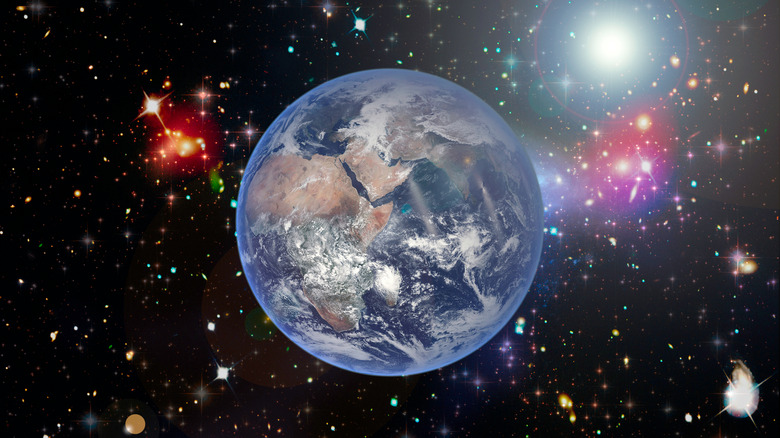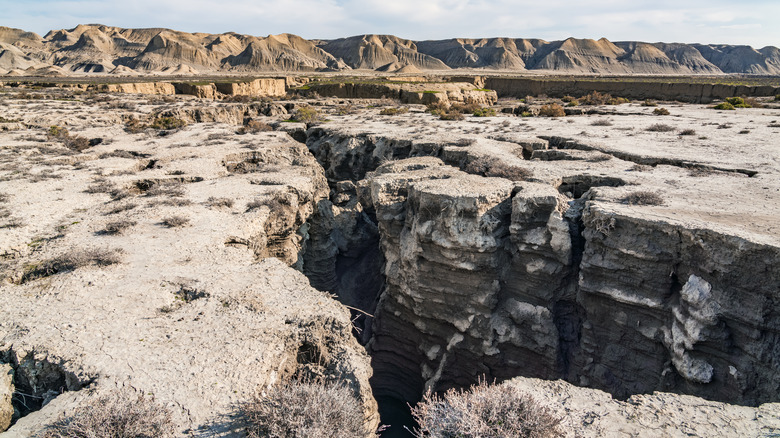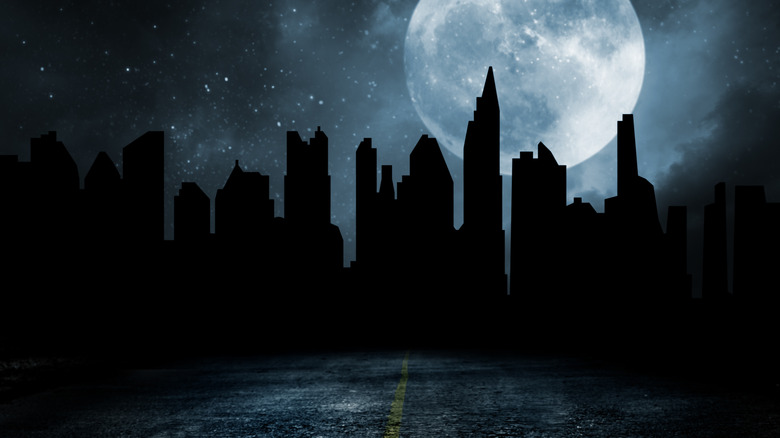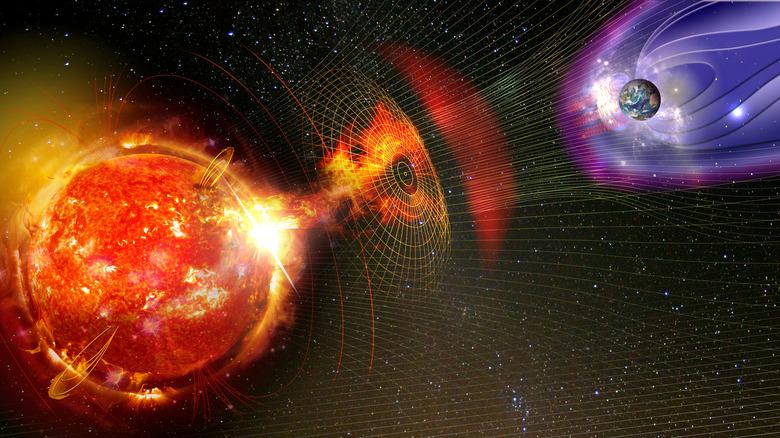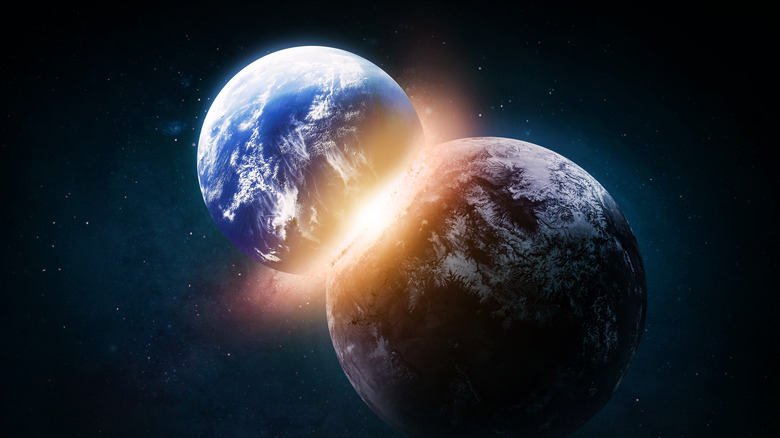Here's What Would Happen If The Earth Was Suddenly Sliced In Half
Agonizing pain, severed pieces, gaping wounds, shock, trauma, and the daunting but real possibility of ... survival? These are all things that could happen if you were cut in half (via ABC News). But what if we took this hypothetical scenario away from you and applied it to planet Earth instead? What would happen if our whole planet was cut in half?
Oddly enough, if the blue planet we all call home was suddenly and symmetrically severed, the result would be quite similar to the aftereffects described above. Sure, there would be scattered pieces, fractured bits, and, due to the slashing of Earth's core, earthquakes would erupt worldwide like arteries in a severed body (via INSH), but survival is still entirely possible, at least initially. In fact, the planet itself is almost guaranteed to survive, although it would go through quite the metamorphosis, and that transformation would likely take hundreds of years and cost billions of lives. Here's how it begins.
Stage 1: Cut to the core
Depending upon the weapon (or entity?) doing the slicing, the process of Earth being cut to the core could either be slow and painful or short and deadly. ScienceAlert reports that we currently and terrifyingly have in our possession a laser so sharp that it can slice right through our planet's atmosphere. It's important to point out that while scientists claim it is that powerful, in real life, it has only been tested across a distance of approximately 870 feet, and there is a huge difference between slicing gases surrounding a planet and slicing through a planet whole.
Presuming the severing has to be done the hard way — through drilling — the process of piercing through the top layer of crust alone holds unfathomably awful implications. As the planet is being hacksawed in half, the rivers and oceans would drain, causing not only drought but also an invasion of saltwater that would poison fields and plant life. We are already witnessing this occur on a small scale along the Mekong River in Vietnam, where miners have extracted approximately 55 million tons of sand, much to the detriment of local residents (via Yale School of the Environment).
According to INSH, if it were possible to slice through Earth quickly and deliberately, the process would result in an eruption of earthquakes as tectonic plates are severed and shifted, and the two halves of Earth spiral into the vacuum of space.
Stage 2: The black sky descends
According to BBC Future, intense geomagnetic disturbances — as well as earthquakes, hurricanes, and other natural disasters that might take place in an extreme event like sawing the Earth in half — have the ability to completely overload electric grids. When these grids overload, mass power outages occur, a phenomenon aptly dubbed "the black sky." Because modern power grids are not just plugged in but also essentially interconnected to almost all basic necessities, an earth-wide power outage would have more impact than just darkness and dead Wi-Fi signals.
The Institute for Risk and Disaster Reduction reports that mass blackouts can have a devastating cascading effect giving way to health issues, contamination, carbon monoxide poisoning, water and food shortages, the sudden cut off of sanitation services, a sudden increase in panic and crime, fires, car accidents, and people just generally being trapped whether that means in their cars, homes, offices, or on elevators (yikes!). The detrimental socio-economic impact of all of the above would be a more pressing issue if anyone was likely to survive. Spoiler alert — the only survivor of this scenario is Earth itself.
Stage 3: Severed but magnetically attracted
If your first impression of a severed Earth was loved ones being separated with outstretched hands as one planet became two, imagine that same scenario and apply it to not only loved ones but also these two newly severed halves of the planet. Cool fact: Earth is sort of this giant magnet that is attracted to itself. In fact, when Earth is whole, this magnetism surrounding the planet is known as the magnetosphere (per NASA). It does some heavy lifting when it comes to protecting the planet from things like charged solar particles and deadly solar winds, not to mention toxic rays of radiation being hurled at us from deep space.
In brief, the magnetosphere works by making the ever-shifting North and South Poles attracted to one another, and this would still be the case if the planet were sliced in half. The two spinning halves would reach for each other like two magnets with opposite charges vying to come together and be whole. This means that while elevators would cease to go up, a whole lot would be going down in terms of matter (via INSH). As the Earth is violently ripped apart, the two halves would hurtle giant bits of matter back and forth across the sky in an intergalactic battle to restore the planet to its former state. This would be at the expense of any human survivors, who would spend their last days ducking bits of concrete cities falling from the sky.
Stage 4: Earth collides with itself
According to the LifesBiggestQuestions YouTube Channel, the power of the Earth's magnetosphere is so prominent that the planet could not remain severed for any real length of time. Almost immediately after it was divided completely, it would be forced back together and would reemerge slightly smaller and scarred. Incidentally, Live Science reports that scarring such as this already exists on the moon, making the scenario more plausible than it appears on the surface.
While the Earth seamlessly coming back together sounds a lot less doomsday than the alternative — two molten spherical pieces spinning in deep space — this crash would indeed be catastrophic. According to HowStuffWorks, the approximate mass of our planet is 6 septillion kilograms, also known as mind-numbingly large. If the impact caused by the two halves crashing was enough to disburse energy exceeding 100 million megatons, then environmental damage alone would give way to mass extinction, ending all life on Earth with a bang (via Scientific American).
To quote astrophysicist and radio astronomer Gerrit L. Verschuur, "Based on the best available computer simulations, the impact of an object a kilometer or more in size would probably trigger the end of civilization."
Stage 6: Impact winter
While it is unlikely that any humans would survive the collision as Earth comes back together, there are still plenty more catastrophes on the horizon. According to Scientific American, the high-impact collision would give way to wacky weather phenomenon. In the initial stages, the planet would be ablaze as a result of global firestorms caused by the downpour of matter. Eventually, dust would settle in the stratosphere, and utter darkness would cover the planet for months on end. The sky around the planet would be a firework of falling meteors putting on a white-hot show nobody would see.
As the dust clears, Earth would enter a stage of prolonged frigid temperatures — a scenario scientifically referred to as impact winter. The Los Angeles Times reports that evidence of an impact winter happening on Earth millions of years ago is currently coming to the surface. Many suspect it was this prolonged period of freezing cold that killed off what was left of the dinosaurs, but nobody knows for sure.
